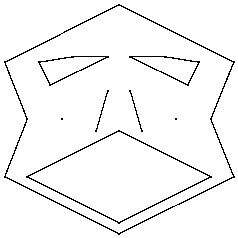
triangle -c dots

When Triangle is used to refine a preexisting mesh, the -c switch will instead produce a PSLG that specifies all the boundaries (including boundaries of holes) of the mesh. This PSLG will also include internal boundaries if and only if the -p switch is used and a .poly file exists for the preexisting mesh.
For example, consider the mesh described by face.1.node, face.1.ele, and face.1.poly (which you saw created on the Delaunay triangulation page).

triangle -rc face.1 triangle -rpc face.1In each case, the boundary segments can be found in face.2.poly.

